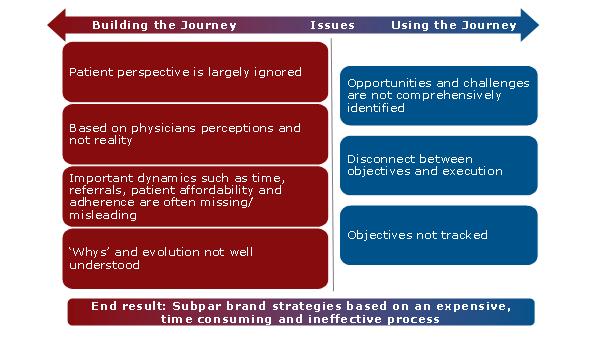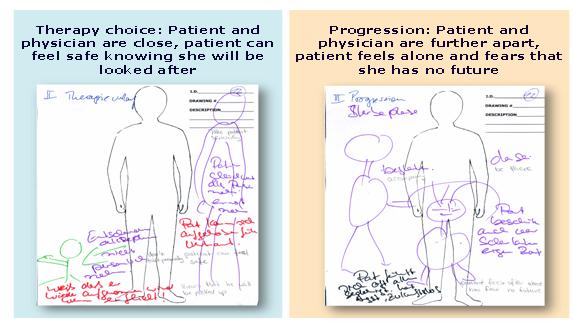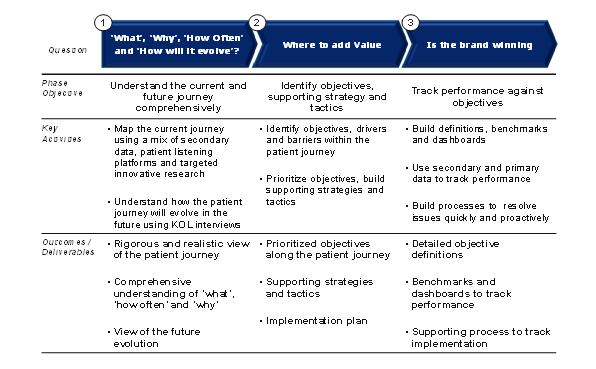A new foundation for designing winning brand strategies - the Patient Journey re-envisioned

Maneesh Gupta
IMS Consulting Group
Medicine has been described as a “science of uncertainty and an art of probability”. The same can be said of marketing, particularly when it comes to developing the foundation of the brand strategy – the “Patient Journey”. The Patient Journey is a powerful framework for understanding the market and designing winning brand strategies. However, several issues in building and utilizing the Patient Journey have limited marketing teams from harnessing the true potential of this rich concept.
The importance of the patient journey
The years immediately preceding a pharmaceutical product launch are arguably one of the riskiest periods in business. “Getting it right” has never been more essential – nor more challenging – given increasing development costs, shrinking pipelines and growing patent losses. Even after a product is launched, the amount of change in the marketplace dictates that brand teams must constantly refresh their understanding of current conditions and alter their strategy accordingly.
The Patient Journey is a description of how patients experience a disease or condition from their first awareness of symptoms through all stages of presentation, diagnosis, referral and treatment, fulfillment and adherence, finally culminating in a cure, remission or death. A comprehensive depiction of the Patient Journey will provide both quantitative data surrounding each milestone on the Journey, as well as qualitative data on what patients, caregivers and providers are thinking and feeling.
 ,
"The years immediately preceding a pharmaceutical product launch are arguably one of the riskiest periods in business."
 ,
Due to the long list of what, why, where and how questions that must be answered before a company can devise an effective product strategy, most companies must first seek an understanding of the Patient Journey when a compound is in Phase II of clinical development. Additionally, because the market is dynamic, one’s understanding of it cannot be static. The Patient Journey should be revisited when launch is imminent and at least every two years once the product is on the market.
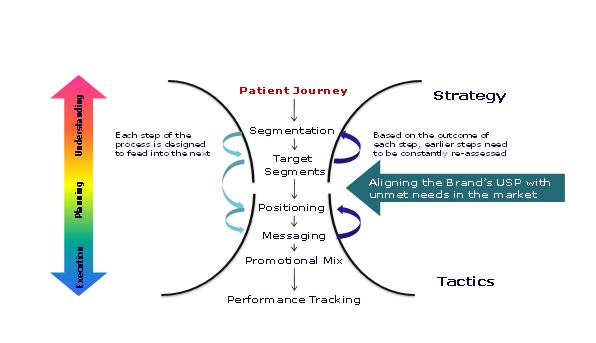 Figure 1: A patient journey lays the foundation to a solid brand strategy
Figure 1: A patient journey lays the foundation to a solid brand strategy
Early journeys
For many years, companies built their Patient Journeys on data collected via primary research with physicians. These studies, typically consisting of interviews with a few dozen physicians followed by a quantitative survey of a few hundred physicians, were at one time the soundest approach available. However, despite the fact that the market environment has evolved considerably, and patients, caregivers and payers have become important decision makers, the approach to building and using Patient Journeys has stayed primarily the same. This introduces inherent shortcomings that limit usefulness in forming business-critical brand plans. Relying on decades-old approaches in building Patient Journeys is no longer acceptable.
Figure 2: Several issues in building and using the patient journey have undermined the potential of the concept
A new journey of discovery
With the availability of the latest, comprehensive methods for understanding the Patient Journey, companies can proceed with new-found confidence in the foundation for their brand plans. Ideally, a description of the Patient Journey will extend from disease awareness through final treatment, covering not only the current situation, but how the treatment paradigm is likely to evolve in the next few years. Additionally, it will not only reveal what happens and how often, but why it happens – both from the physician’s and the patient’s perspective. Obtaining such a comprehensive view requires the combination of multiple research sources and methods.
Secondary data
For the past decade, it has been possible to use a wealth of secondary data sources to analyze patients’ touch points with providers – creating a map of how patients flow through the system from diagnosis through adherence. The input for these maps comes from diverse and rich databases, including EMR data from physician offices and hospitals, diagnostic data from labs, longitudinal patient-level databases and claims data covering diagnosis, treatment and adherence, and managed care data covering prescription fulfillment.
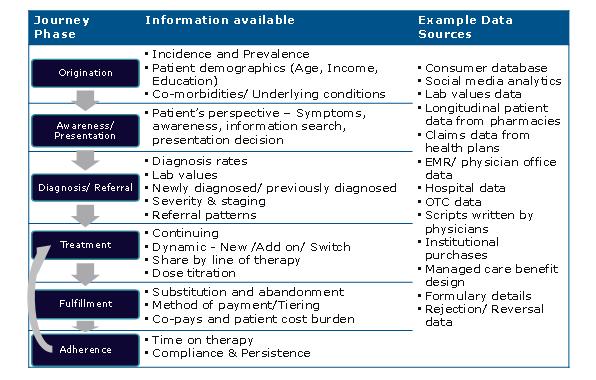 Figure 3: Secondary data sources can help develop a rigorous and realistic view of the patient journey
Figure 3: Secondary data sources can help develop a rigorous and realistic view of the patient journey
Drawing from an array of such robust databases that incorporate information on millions of de-identified patients and thousands of physicians and payers, one can quantify the treated patient population and various market dynamics. In addition to providing a standardized framework that is easier to refresh than primary research, it provides the most accurate view of actual patient behaviors. This research answers questions such as: “How many patients reach each step of the Journey?”, “Are there patients who never get drug treatment?”, “How many patients move through multiple treatments?”, “Do patients fill their scripts and adhere to their treatment regimen?”, “How does the cost burden influence patient behavior?”, as well as many other questions.
"The rise of social networking has given patients an electronic avenue for practicing ‘peer-to-peer healthcare’..."
Social media listening platforms
The rise of social networking has given patients an electronic avenue for practicing “peer-to-peer healthcare”, the tendency of patients to “lend a hand, lend an ear, lend advice”, using the speed and scale of the Internet. In fact, patients can become members of online communities through such sites as PatientsLikeMe.com, MedHelp.org, and CureTogether.com, which instantly connect them to fellow sufferers.
At minimum, companies can “listen in” to public conversations conducted via online forums to get a sense of what is on patients’ minds. Ensuring, of course, that all laws and FDA guidelines are followed, companies can gain more systematic insight into conversations conducted in social media through data aggregator companies, which scan social media key words and then code and analyze them for trends.
Importance of emotional drivers for patients’ and physicians’ behaviors
Experiences, opinions and decision making exist in two domains – the rational and emotional. Often, individuals are unaware of the important emotional drivers of their behaviors, as many act on a subconscious level, and influence the more easily observed rational processes. To understand the underlying emotional themes that drive patient and physician decisions it is generally necessary to use less direct research techniques. Under direct questioning, respondents do not always speak the truth. They can be embarrassed, they can anticipate the answer the interviewer is seeking, or they can be unaware of their inner emotions and only present rationale explanations for their behavior.
One solution is to use projective research techniques, such as those employed in psychological diagnosis and assessment. These techniques prompt those interviewed to project their beliefs and feelings onto an ambiguous stimulus – such as an incomplete picture or story. When asked to draw themselves with cancer patients, oncologists drew dramatically different pictures at different stages in the disease progression. Initially, they showed themselves as holding the patient’s hand. However, once the cancer had recurred, they added space between their figure’s and the patient’s. Once the tumor had metastasized, physicians stopped drawing the patient’s facial features and portrayed the tumor as the patient’s dominant feature. This reflected physicians’ need to disengage emotionally as they lost control of their fight against the disease. Ultimately, the cancer came to define the patient in the physicians’ eyes.
 ,
"Often, individuals are unaware of the important emotional drivers of their behaviours..."
Figure 4: Oncologists Draw Dramatically Different Pictures at Different Stages in the Disease Progression
Trained clinicians provide the necessary insight to design tasks to generate emotional responses from the subject. Drawings are categorized according to the presence and omission of indicators such as positioning, color, affect, size, and quality of shape and line. Placement of forms, erasures, and manipulation of materials also reveal nonverbal attitudes and levels of emotions.
 ,
"Once the tumor had metastasized, physicians stopped drawing the patient’s facial features..."
 ,
Using the patient journey effectively
While having a comprehensive Patient Journey in hand is essential to creating an effective brand strategy, that alone is no guarantee of success. Companies must translate the insights from the brand plan into a strategy and tactics that are implemented and measured. Most pharma companies do a decent job of identifying behavioral objectives in the Patient Journey and prioritizing them. However, when it comes to laying out action plans behind these behavioral objectives, we have seen several brand teams falter. Many times the Patient Journey effort is stopped prematurely after the behavioral objectives are identified. In reality, aligning on the behavioral objectives is just the foundation to winning in the marketplace.
Even as brand teams conduct awareness, trial and usage (ATU) studies throughout the year, there is often not enough attention paid to tracking performance on behavioral objectives. Brand teams can follow the five step process outlined below to ensure that the brand is winning in the marketplace.
1. Identify and define leverage points, e.g. patient adherence.
2. Design and implement tactics to influence, e.g. co-programs with hospitals and health systems, patient apps and SMS reminders.
3. Develop methodology and definitions for performance tracking, including defining the targets, e.g. ensuring that 80% of patients stay on therapy after 3 months, as seen in longitudinal patient-level data.
4. Develop a dashboard for performance communication, e.g. looking at persistence curves on a monthly basis.
5. Design and implement performance mitigation plan, e.g. e-mail blasts if persistence is below 70% after 3 months, and kick-off market research to understand why patients are not adherent.
We recommend the following, methodical approach for taking full advantage of the Patient Journey, based on several years of experience across hundreds of engagements.
Figure 5: Recommended Approach to Building and Using the Patient Journey
Conclusion
Combining the latest research methodologies and thinking to gather information on, and insights from, physicians and patients will produce the most comprehensive, rigorous and actionable Patient Journey possible. Such a well-designed and thoroughly researched Patient Journey will give companies the basic foundation for formulating a successful brand strategy. Beyond identifying the objectives for success, companies must then use a systematic process for achieving success: outlining tactics, tracking progress against those goals, and closing the loop by making adjustments to the plan as indicated.
About the authors:
Dr. Simone Seiter and Heather von Allmen, of IMS, and Howard Jaffe, of TRiG, contributed to this article.
Maneesh Gupta is Principal, Brand and Commercial Strategy, with the IMS Consulting Group and is an expert on patient journeys. He also co-leads the Launch Excellence practice and in this capacity works with clients on launch strategy, planning, tracking and capability development. Gupta has over 15 years of experience in consulting, strategy, marketing and product management. He earned an MBA, with a concentration in Marketing, from the University of North Carolina, where he was invited to join Beta Gamma Sigma Honor society. Gupta also holds a BSc in Chemical Engineering.
In what ways can the Patient Journey help formulate a successful brand strategy?

